
Many Ukrainian museums are still known to be conservative, not to say «outdated». And that’s why it is even more interesting to watch some of them trying to turn the present into history right before our eyes.
In Ivano-Frankivsk, there are three museums, each of which is dedicated to the memory of a certain history: the Heroes of Dnipro Museum, the Museum of the Heavenly Hundred and the Regional Liberation Struggle Museum after Stepan Bandera. Although all of them are supposed to be connected with completely different events, each of them in its own way works with a particular period of time: between the Revolution of Dignity and the present.
Museum for the military
They greet us—me and Yulia, a photographer who went on a tour with me—a little cautiously at the Heroes of Dnipro Museum. We can enter it without any problems, but we are not allowed to photograph the exhibits. At least until the director returns, because he is the only one who can give permission. «Because different things happened,» the museum employee explains. «They say one thing and then write something completely different.» Clearly, we are not the first to come to the museum called «Heroes of Dnipro» with some skepticism.
Perhaps this explains why there is not much space provided for the battle for Dnipro: modern historians regard this event as not the same as the Soviet ones but in a completely different way, so the propaganda exposition disappeared from here already in the early 90s. Obviously, in Soviet times, it had a significantly different focus. Today, hardly anyone would want to focus on the heroization of one of the bloodiest operations of World War II, which cost the lives of more than a million soldiers, many of whom were Ukrainians. Nevertheless, the name is still here, though mismatching the museum’s content. It’s a protocol memory of history.
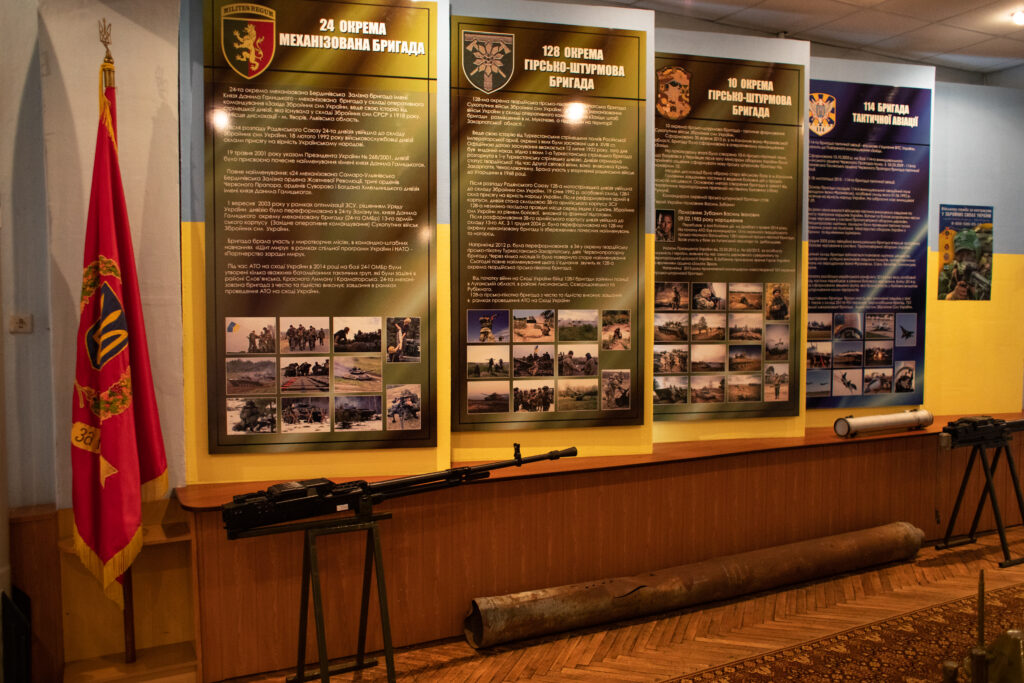
Today, it would be more appropriate to call this institution a «museum of military service” because, in fact, this is the only topic that unites all the halls and exhibits. Of course, the first floor begins with a detailed overview of World War II with stenciled plaques indicating the years of the war still hanging on the door. But this is just the way the Heroes of Dnipro Museum works: the external form of the institution no longer corresponds to its internal content, but it forcibly remains as it is, as if according to the statute. After all, the museum is subordinate to the Ministry of Defense, not the Ministry of Culture.
And this could be felt to the extent that its halls full of rusty and new weapons (ours and trophy ones), uniforms of different times in glass cabinets and information boards resemble a very rich class for the pre-conscription training of youths.
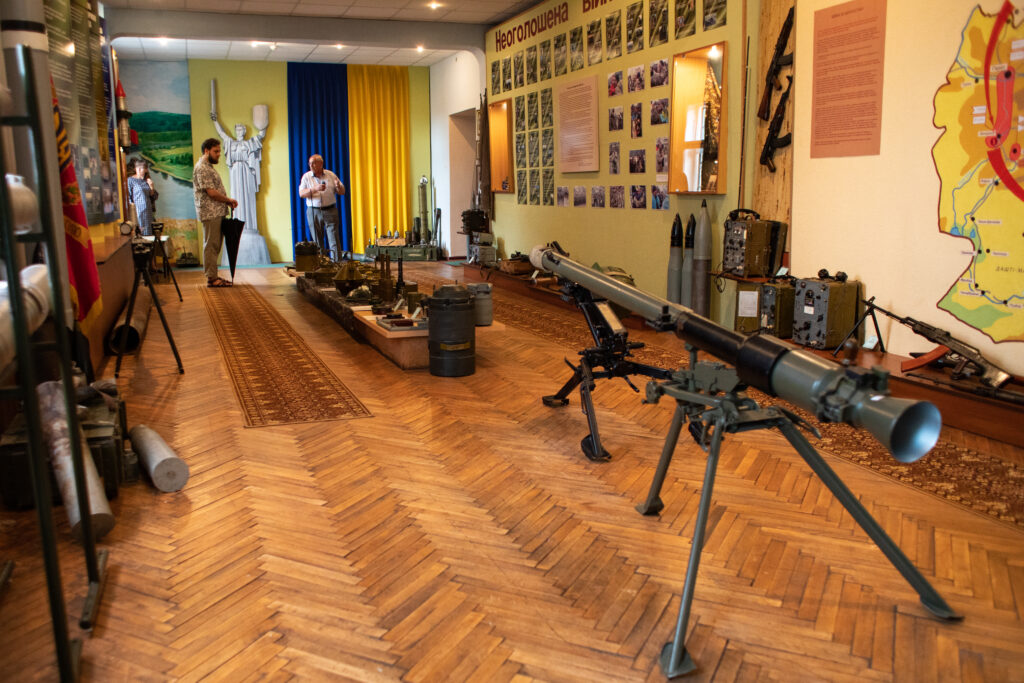
If you skip reading the accompanying documents (there are few information boards near the exhibits) and just look at what the exposition offers you, you can feel as if you are at an exhibition of weapons of the 20th century: ranging from a large mortar that greets you at the entrance to an entire stand of anti-tank mines of various caliber located in the largest hall dedicated to the nowadays war.
From this hall, you can enter the last room of the museum, the Ethnographic Hall. Like every decent Soviet museum, this one used to have a «people’s room», a kind of analogue of a «red corner», which would show the inextricable connection of local tradition and aesthetics with the Soviet government. «Red corners» were among the first to fall under the weight of common sense and rest in peace together with the pioneers. But in many places, the «people’s rooms» kept their original Soviet look and did not undergo any reinterpretation because they were protected by the «people’s culture» vibe.
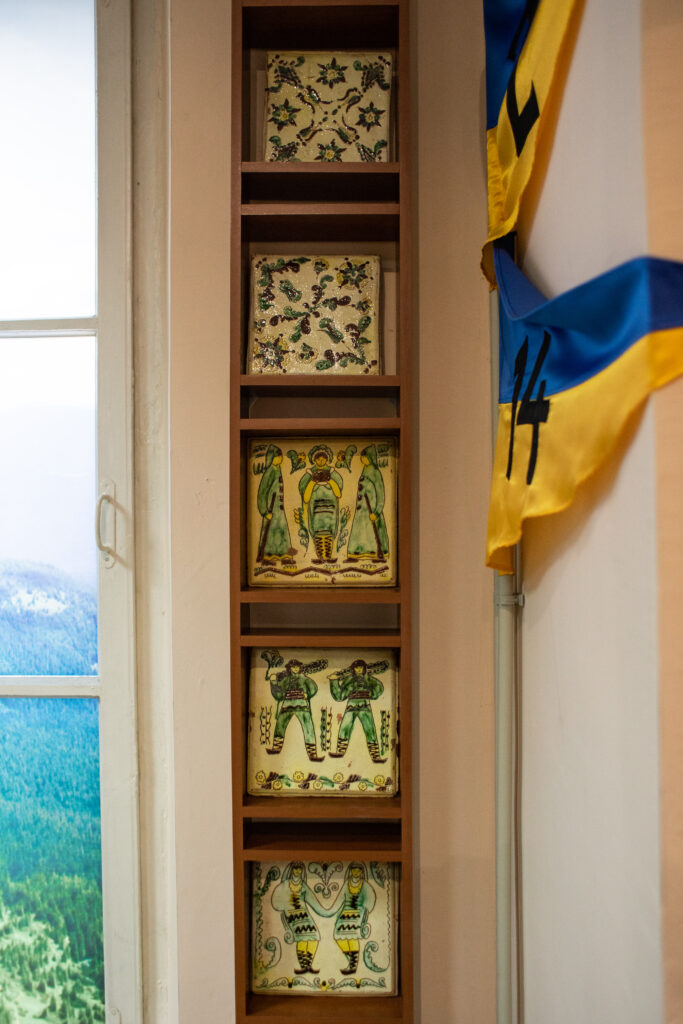
The most noticeable in this exposition are the Kosiv tiles with images of cosmonauts and Red Army soldiers, as well as a large panel, a wonderful example of Soviet poster art, with personifications of the largest cities and industries of the Ivano-Frankivsk region. The only detail that stands out from the composition is the coat of arms on the shield in the middle. Instead of the Ukrainian SSR coat of arms that you might expect to see, or perhaps just a hammer and sickle, there is the Pilawa (Polish coat of arms) with a gate and three towers, the real emblem of the city.

But beyond that, the panel is so stereotypically poster-like that I again try to convince the museum worker to let us take a few photos. But no luck.
Fortunately, Yarema Kvasniuk, the director of the museum, comes and allows us to photograph as much as we want and whatever we want, not forgetting to remind us about the dishonest journalists who are clearly pestering this museum. Mr. Kvasniuk also sheds light on the propaganda panel. According to him, this is not a commissioned piece, but a diploma project of a graduate of the Institute of Arts at the Vasyl Stefanyk Precarpathian National University created in 2006 and donated to the museum.
This discovery greatly highlights a systemic problem that the museum doesn’t even try to hide: a lack of resources. Not just money that can be spent on repairs or buying new equipment. But resources in general, and human resources in particular capable of properly reorganizing the space, instead of simply removing ideologically dysfunctional elements from it and adding new ones. The lack of resources that would allow to turn a collection of halls into a unified informative exposition is a weak and strong side of the museum.
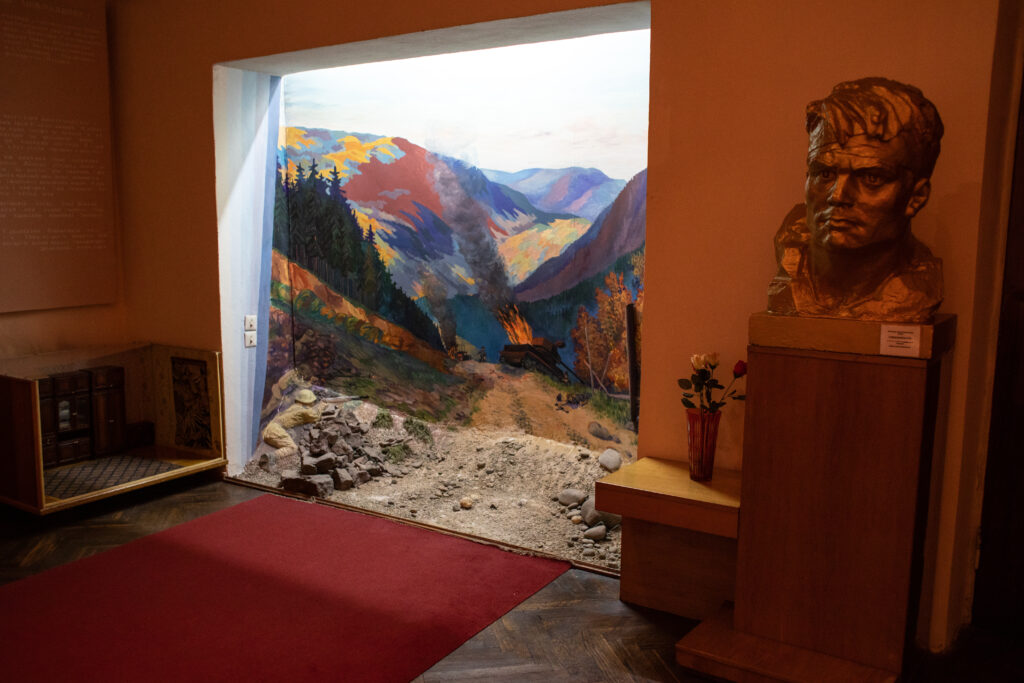
The institution doesn’t try to be bigger than what it is, which sometimes leads to funny or silly exposition decisions. But everything that does not concern the processing of exhibits, but only their technical placement, works perfectly. Hence, in fact, the comparison with that class. The walls in the «Exposition of our time» are covered with information boards with the history of modern brigades that today protect Ukraine at the frontline. The relics of Soviet officers complement the relics of modern officers in the linear accumulation of material history.
But the more carefully we look at the exposition and the more the director has time to tell, the clearer it becomes: it is not intended for us at all. That is, in general, not for the people who usually visit museums.
«We are a structural unit of the National Museum of Military History of Ukraine,» Yarema Kvasniuk says.
«We are in the same line: we do everything that the Ministry of Defense does. But they face more specifically military tasks. And what is related to moral and psychological support — those are our tasks to fulfill.»
Although the exposition dedicated to the years 2014-2022 is currently only in the process of formation, the museum has long performed a much more important function in the life of the military than in the life of the community. With a large collection of small arms, explosives and radio-electronic devices, the facility also functions as a lecture hall and laboratory for officers training personnel. In this light, the long podium with anti-tank mines can easily be perceived as an illustrative material laid out in front of the students and the empty table by the window covered with a dark green cloth is not just a randomly left detail, but a workplace where you can practice assembling and disassembling the machine gun. This exposition is much more interactive than it seems to be at first sight. And lots of free space and an efficient arrangement of exhibits only help the museum to be an effective educational space. In these halls, you really want to work with the audience.
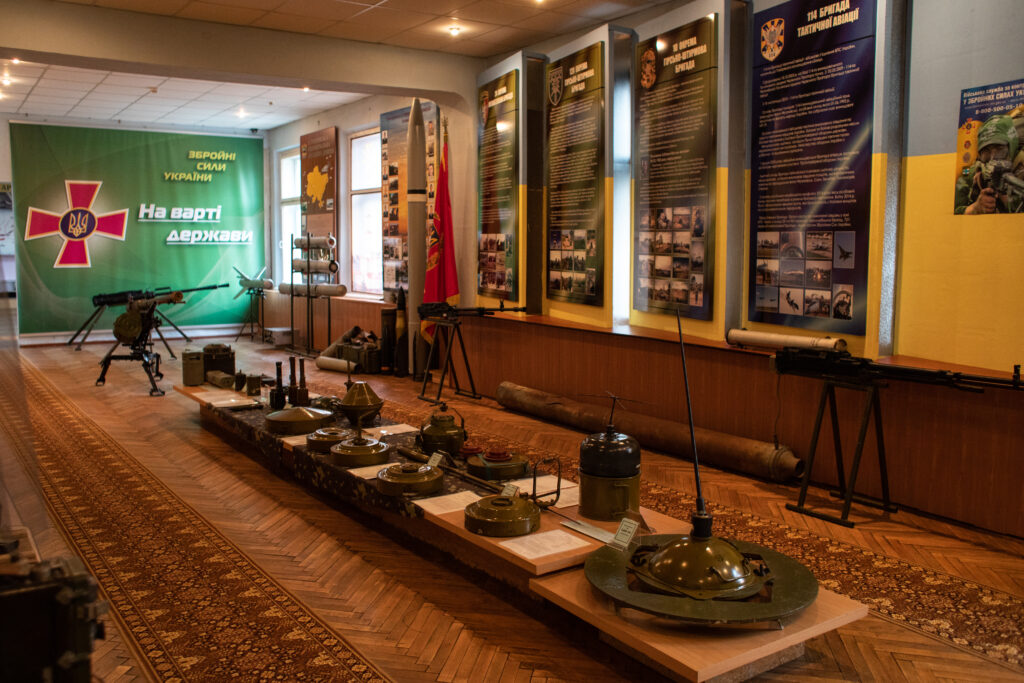
Despite the fact that «there is a war and there is no money», as Mr. Kvasniuk jokes, the exposition is being constantly changed. Some things, such as the informative part of the exhibition about the present times, are done by the museum staff themselves, and the other ones, like artifacts from the war, are brought by the military themselves (and now too). But due to this forced specialization of the museum, another problem remains unnoticed.
According to the director himself, most of their funds (objects outside the exposition) are documents. Since the museum was created precisely as the one specializing in World War II, many people can find information about their ancestors in those funds. Among those who died in our region, there were many mobilized from other parts of Ukraine, so each such archive is thousands of family stories. Just as the museum seeks to present the nowadays war through the stories of individual people, stories from the Soviet times also revolve around individuals.
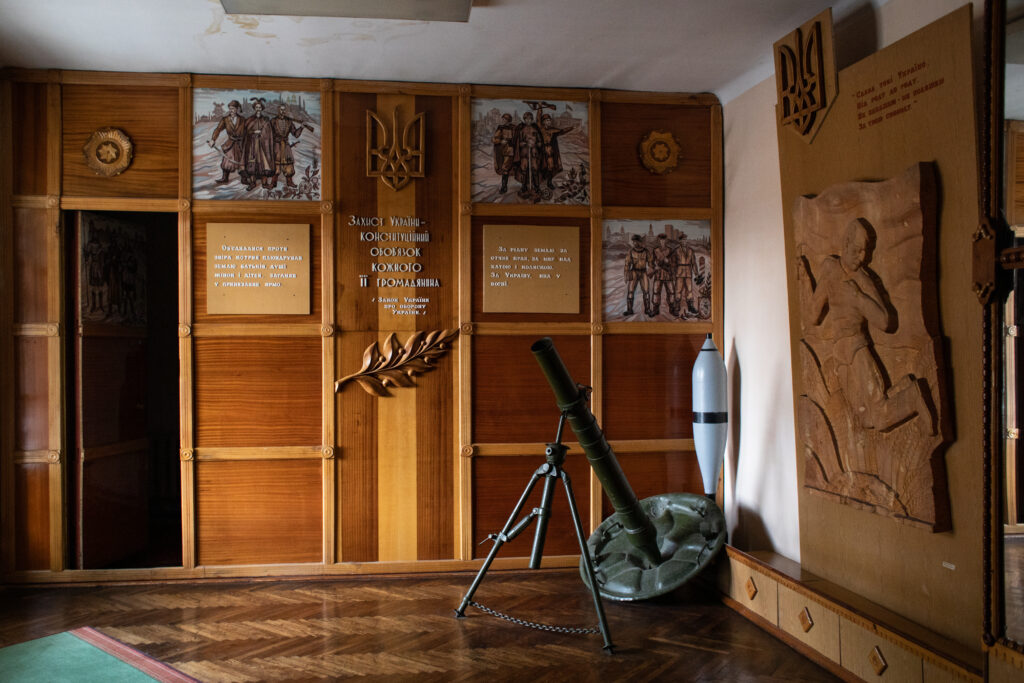
But ordinary people cannot get into the funds: there is no standard procedure that allows them to be used. It all depends on the human factor and how good a reason you have to work with them. You need to be a researcher with a valid reason to work with a particular fund (and have a supervisor to refer you there), and you need to get permission. There are no options like «There may be information about my ancestors» or «I’m just interested in history». The museum is gradually digitizing documents from its collections, but does not publish them anywhere, taking the same position on this issue as on other ones: when there is an order from the Ministry of Defense, then we will talk. In the near future, of course, this order will not be issued, because the ministry has much more important things to deal with. But the thing is that one does not need it to publish unclassified documents.
Regarding some issues, there is this incredible interactivity, while the others are still immovable. But at least in this case, we can honestly say that we came at the wrong time.
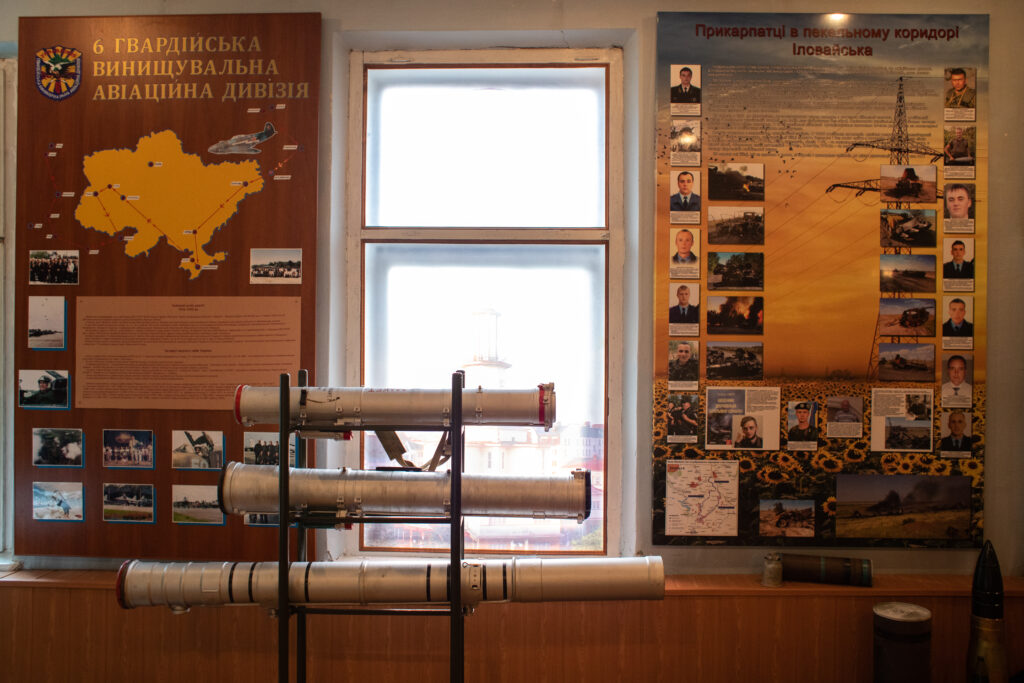
Museum for witnesses
The Museum of the Heavenly Hundred evokes extremely conflicting impressions.
On one hand, it is not a museum in any modern sense of the word. On the other hand, perhaps of all, it is the closest to the ancient Μουσεῖον, the home of the Muses.
They say it’s too often closed during working hours. But we had no problems with entering it. On the contrary, the founder and actual director welcomed us with great enthusiasm.
This space was created by the artist Roman Bonchuk, and it is the artist’s hand that is best seen here: a large hall is cut in half by an installation with a huge painted panel on the Maidan. The figures are ragged and faceless, as in a moving crowd, and in the foreground is a barricade covered with black cloth with barrels, shields and tires. The walls are covered with portraits and paintings, as in a gallery. Almost every large canvas has a small altar in front of it topped with a construction worker’s helmet and a rosary or something like that. Under several portraits, there are small collections of personal belongings of the heroes granted to the museum by their families.
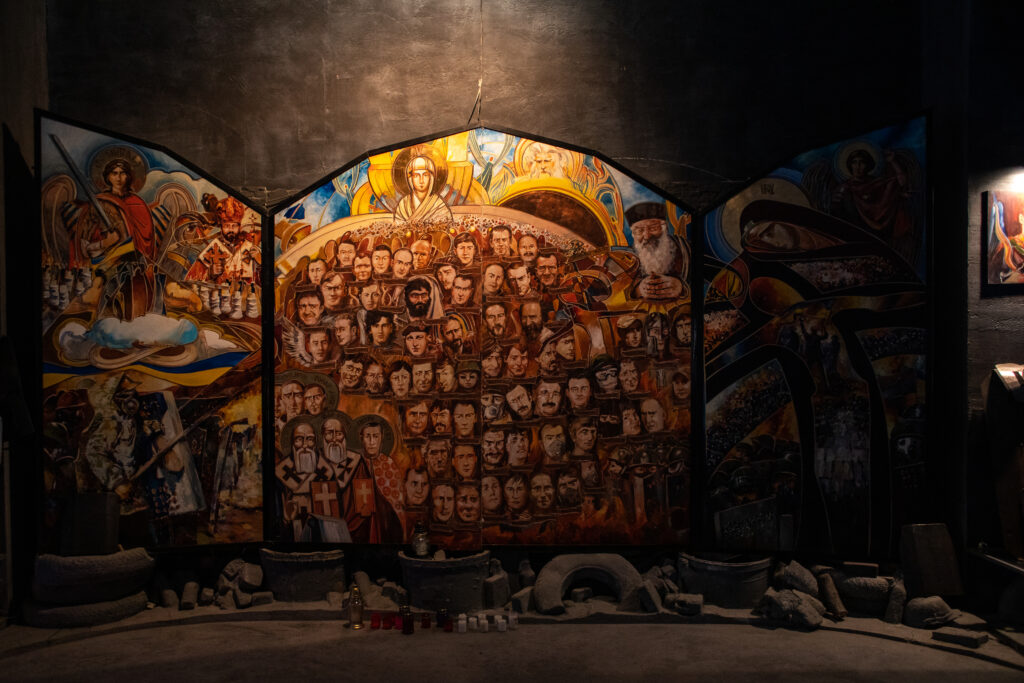
After looking at the monumental panel, we spend a few minutes looking for the exposition, until we realize that we are not really in a museum, but rather a temple of memory. One of the first large canvases that hangs at the entrance is a triptych depicting the heroes of the Heavenly Hundred as a host of saints from Christian iconography. Angels hover above the portraits of the heroes. There are candles and lamps on the floor. Further along the wall, there are many more images, personal belongings, icons and sculptural fragments, found objects, candles, thematic quotes, and stickers with the caption «they live in our memories».
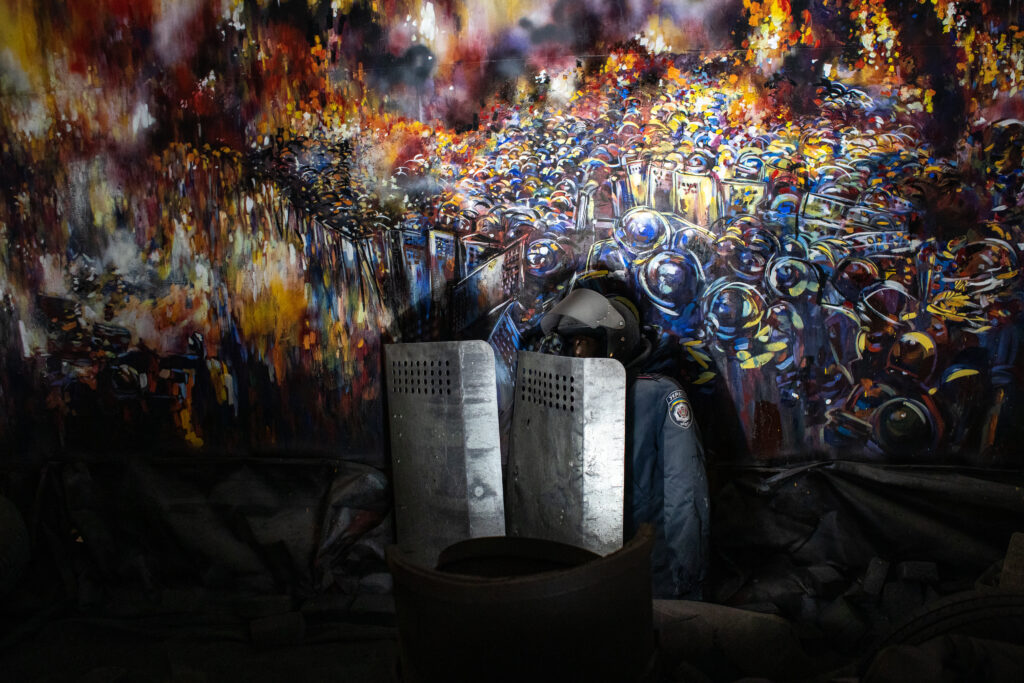
The space gives the impression of grassroots. This is achieved through the combination of the artistic decoration of the premises made by its director with an absolutely sincere religious worship of what the decoration depicts.
The utility rooms are also open for the view: pyramids of sleeping bags and rugs lie there among piles of paintings invariably and clearly related to politics. This is humanitarian aid that will soon leave for its destination, but here and now it gives the impression of another installation. The museum space is so consolidated that it «lends» its meaning to almost everything that happens to be in it.
A narrow corridor stretches behind the panel. Out of the entire room, it resembles a real museum exposition the most. If the main hall functions as a temple with several large altars, here we see rather personal altars. A special place is dedicated to Roman Huryk, some of his personal belongings are stored here under the glass reliquary.
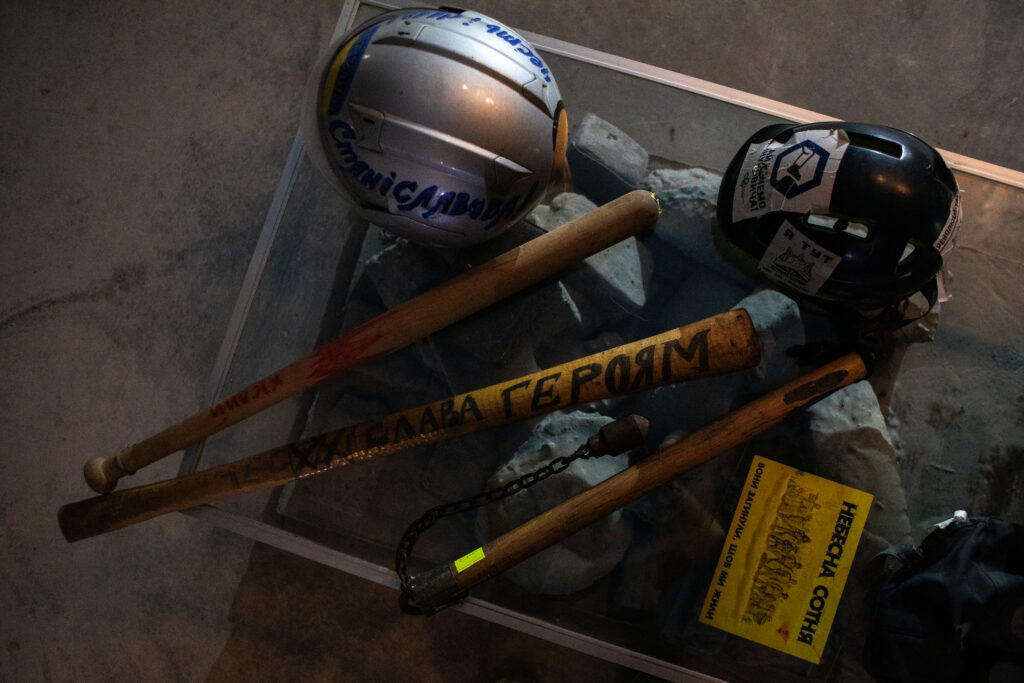
From the director’s story about the museum’s life, it becomes clear that the main highlight of the space is at the same time a problem that will only worsen over time. The «most scandalous» place here is a mannequin with an amputated leg lying on the table, and on the floor next to it there are blood stains and the inscription «DO NOT STAND WITH YOUR FEET».
Anyone who has been to the Maidan understands this installation without any comments, but «the kids who have already been here and know what it is about immediately run to take a selfie just as they come».
Despite the fact that the museum is often visited by kids, the stories give the impression that they don’t quite understand some of the exhibits.
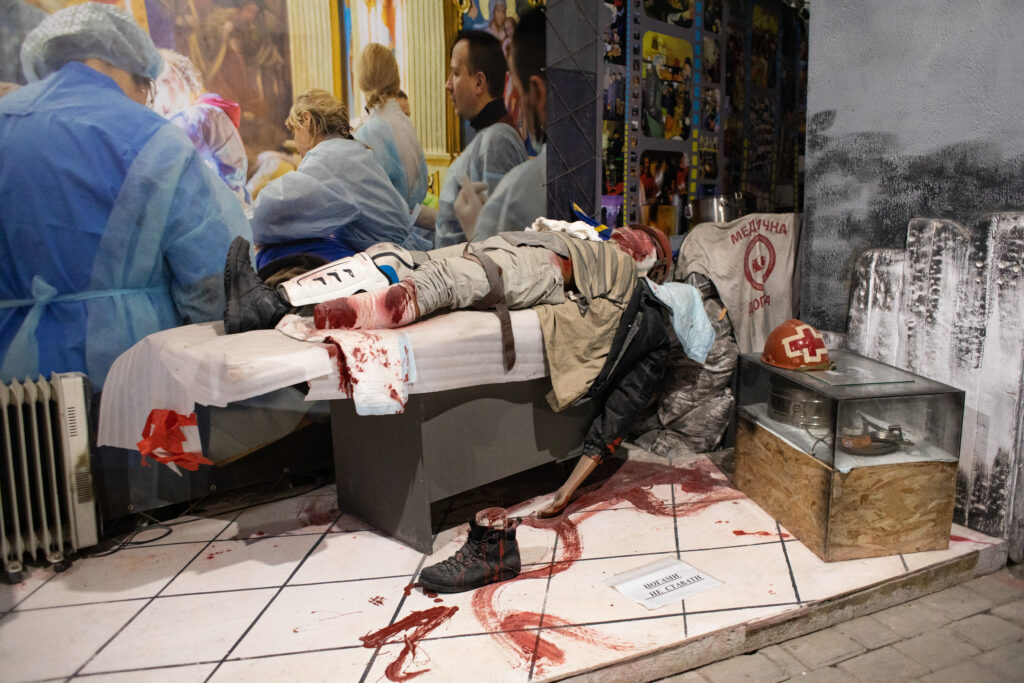
Actually, this is a side effect of the space’s temple nature. People for whom this is a direct memory find their way around the symbols and meanings of the museum very easily. But children for whom this is only the first immersion in the topic need at least a qualified guiding lecturer, and even this does not guarantee any success. However, this is a case where repetition reinforces the result: with each visit, one can find something that was not noticed before. And if to take the experience here as a way of remembering rather than knowing, as a cultural and religious practice rather than an intellectual one, perhaps this museum could be considered truly unique.
Even the facade which evokes a full range of emotions in many people—from non-acceptance to discomfort—plays its own role. It does not fit into the surrounding space at all and screams with epatage, despite the dominance of gray color. But, in fact, this is exactly what most nowadays Ukrainian temples do. Therefore, according to the context, it is in its place.
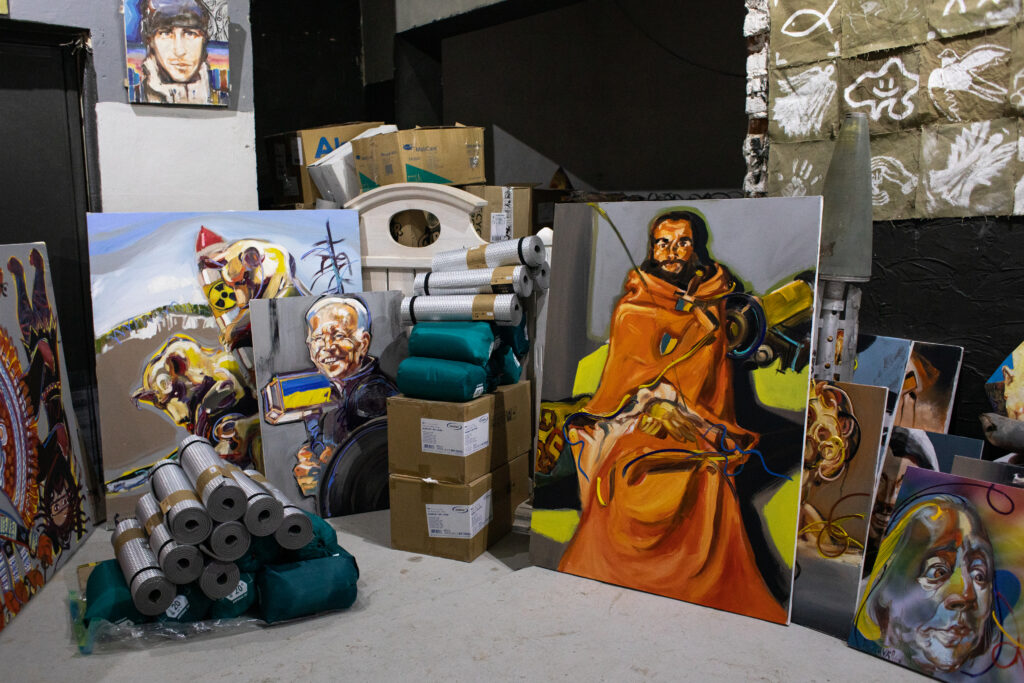
Museum for reports
The Regional Liberation Struggle Museum after Stepan Bandera is located in an old townhouse on Tarnavskyi Street. This street consists mainly of turn-of-the-century houses, besides, it is quiet and close to the train station. By all indications, it should be popular among people who have only an hour or two of free time in Ivano-Frankivsk. And the museum could be the first logical stop on the route to the center.
Unfortunately, it is not. On Tarnavskyi Street, almost opposite the museum, there is the MIF hostel, a well-known place among tourists. Despite this, the street gives the impression of being completely abandoned. The number of neglected townhouses is increasing, although the museum is still holding on, as far as funding and circumstances allow. When we enter it, we find ourselves the only visitors (as, after all, in the previous two).

Oksana Romaniv, the deputy director of the museum, shows us the icons from the church of Staryi Uhryniv saved from looting by the villagers. The fact that they are displayed in the hallway hints at semantic dominance.
Oksana begins her story with the Bandera family. The posthumous mask of Stepan Bandera lies here in a prominent place, and only behind it does history begin to move in chronological order: from the Ukrainian Sich Riflemen and World War I through the Ukrainian Galician Army, Ukrainian Military Organization, Organization of Ukrainian Nationalists to the Ukrainian Insurgent Army. We start with the «main» topic of our liberation struggle, and then we move on to the «ordinary» ones. Information boards and maps are interspersed with old weapons and uniforms, documents and photographs create a continuous thread of history, even if not to read or look at them attentively.

But with each subsequent stand, one feels how cramped this museum is. Its foundation was laid by excavations carried out by the Memorial Society in 1989 in the Demianiv Laz tract near Ivano-Frankivsk. The museum was built much later, but this local tragedy was the basis of its creation. At the same time, the part of the exposition dedicated to Demianiv Laz is huddled under the stairs in several closets, because there is really nowhere else to put it.
The museum contains much more information than the space allows to present. Each free tiny place in it plays some special role. That’s why it seems that it is quite tight inside, although it is not. This feeling arises because in some rooms most of the exposition can be viewed from one place.
The second floor tries quite successfully to seem larger. This effect is achieved with a semi-diorama depicting a hiding place, or kryivka, and several photos enlarged to almost life-size, which «open» the space deep behind the walls. The second floor was clearly arranged with the idea of giving visitors at least partial immersion, and then it was also remodeled and improved. It would be interesting to see what the same exposition could offer in a normal space and with sufficient funding, but it has not happened so far: even the information boards here are still written by hand.
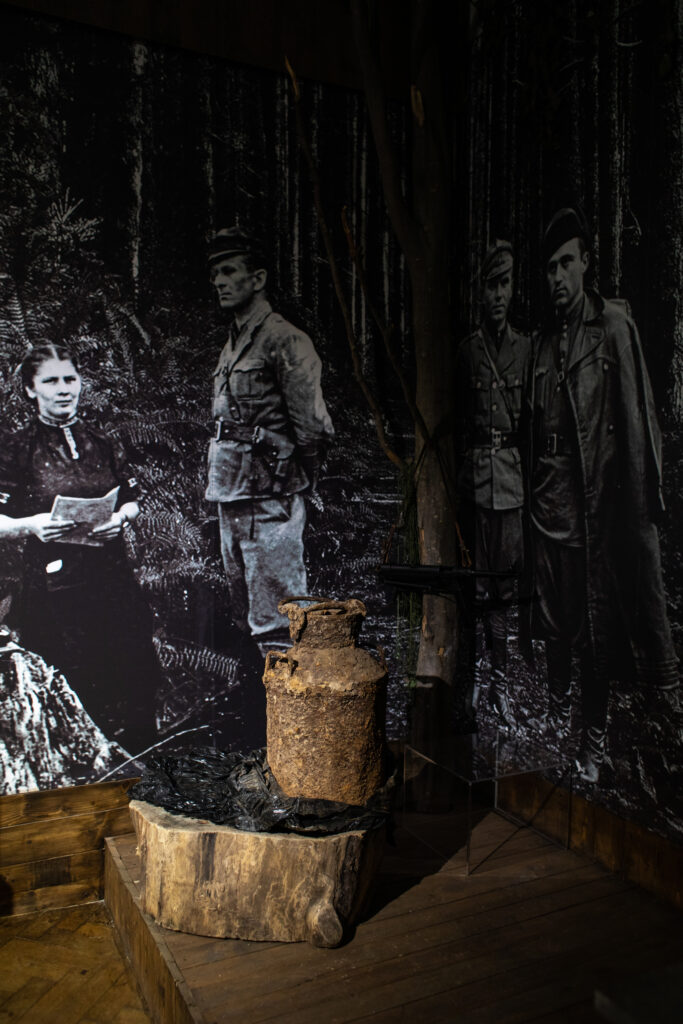
Several times during our excursion Oksana scolds officials who do not take care of the museum. It sounds like a typical complaint of every civil servant, but the claims of this museum have much more weight. Of the three museums we visited, this is the only one subordinate to regional (or simply local) authorities. While the Heroes of Dnipro Museum is entrusted to the Ministry of Defense, and the premises of the Museum of the Heavenly Hundred are managed by Oleksandr Shevchenko (it is owned by the infamous company «Scorzonera» responsible for the destruction of the Ivano-Frankivsk airport), the Regional Liberation Struggle Museum depends entirely on the regional administration and the wishes of the Regional Department of Culture headed by unchanging Volodymyr Fedorak to do their job. And, as we know from the long-term policy of the Regional Department of Culture, it is easier not to work than to work. Qualitative steps towards the development of the tourist infrastructure, which we already have, are practically not seen.
Oksana does not see them either. From her words, one gets the impression that for the local authorities, the museum performs the function of an ideological sphere of services, which simply exists, and not a historical and cultural space that needs to be developed, or a (albeit tragic) heritage that needs to be properly preserved.
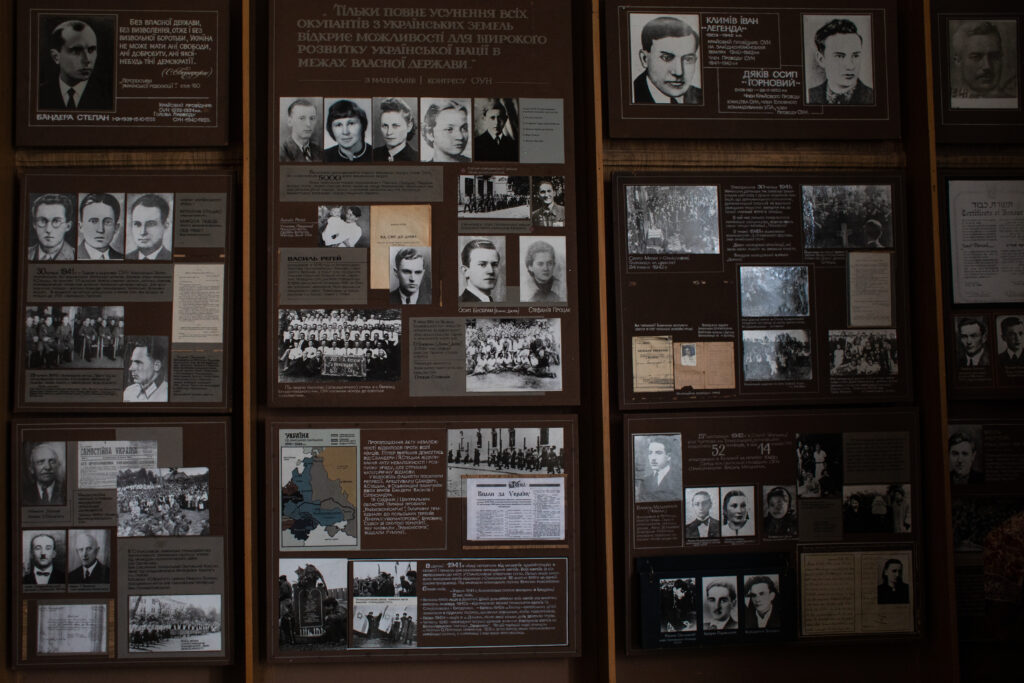
Unfortunately, this is especially noticeable in the last halls of the museum. The artifacts of the last nine years are already here, but a way to combine them in some way has not yet been found. History continues, but there is no more space and resources. Therefore, the exposition of 2014-2022 tries to follow the same style as the rest, but here one can see work in progress and not ready conclusions.
A legless mannequin in pre-pixelated Ukrainian uniform sitting between two racks seems to be the whimsical coda of this exposition. It is as if completely out of place as if placed temporarily and without knowing what it should indicate in its incompleteness. Oksana’s story also ignores this room: saying that you know everything.
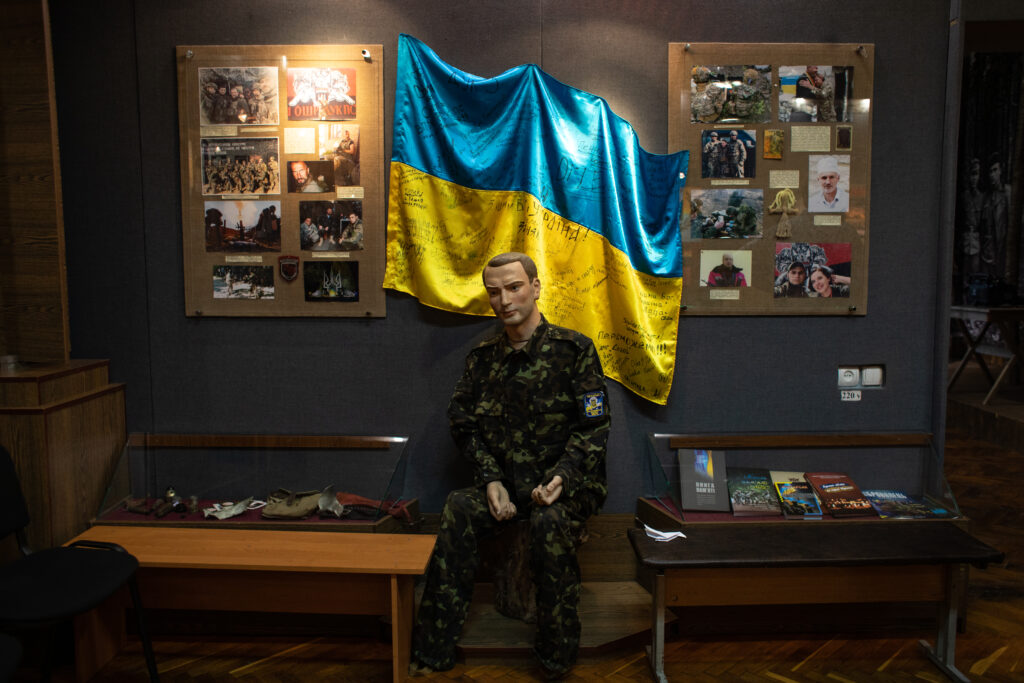
And this seems to be the main conclusion from visiting those three museums.
We know that reality needs to be discussed and preserved but we don’t know in what way.
When it comes to national commemorations or official events, there is an illusion that we have a shared narrative and perspective on the events of the past decade. But when we try to create an external medium, a place that will preserve our memory for every day, it becomes especially clear that each of us is really talking about ourselves. Modern history is tried to be accumulated everywhere, either in a room or at least in a corner. But no integrated strategies for working with this history are yet visible at the local level, just as there is no visible support.



